 |
Shrimp Po-Boy |
The Po-Boy is the other face of New Orleans cuisine. The city is known for its grand restaurants and unique Créole cuisine, but the more humble fare like the po-boy is also very popular. The Po-Boy is a traditional and unique sandwich from southern Louisiana. It consists of New Orleans French bread, and either fried seafood (oysters, shrimp, softshell crabs, catfish), or Louisiana spicy sausage, or hot roast beef with gravy, etc. The fried seafood variety is usually served "dressed", which for the uninitiated means shredded iceberg lettuce, sliced tomato, mayonnaise, and pickles.
The basis of every Po-Boy is New Orleans French bread. The name implies a French origin, and one might think that to be very likely given the rich Francophone heritage of the city. At first glance, New Orleans Frech bread does resemble the French baguette. However, the French baguette is thinner and has a thicker, harder and crunchier crust. New Orleans French bread has a very thin crisp crust and soft fluffy center. The crust is smooth, as opposed to the rather rough crust of the baguette. The baguette has a diameter of about 6 centimetres (2⅓ in) and a usual length of about 65-70 centimetres (26-28 in). New Orleans French bread is roughly twice as wide and softer. It is also typically longer, and individual po-boy sandwiches are made about 10 inches long these days.
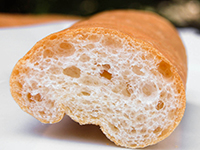 New Orleans French bread (from Seriouseats.com) |
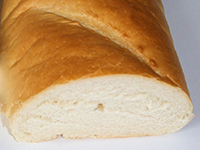 Czech veka, a relative of the Austrian Weckerl. |
Compare these two recipes for the New Orleans French bread and for the Czech veka. They are quite similar and it does seem quite likely that people like Ledenheimer and Binder brought from their native Central Europe their ideas about what white bread should look like, and started making such breads in New Orleans.
This recipe for New Orleans French Bread was published by the Times-Picayune and
attributed to the G. H. Leidenheimer Baking Company:
Ingredients:
- 2 cups warm water (110 deg F)
- 2 tbsp sugar
- 2 tbsp dry granulated yeast
- 2 tbsp vegetable shortening
- 6-1/2 cups bread flour
- 1 tbsp salt
- YIELD: 4 loaves
Preparation:
- Place the 2 cups water in the bowl of a stationary mixer fitted with a dough hook. Add 1 tbsp sugar and sprinkle with the yeast. Allow to sit for about 15 minutes, until the mixture is bubbling. Add the remaining 1 tbsp sugar, the shortening and 5 cups of flour.
- Mix until a dough starts to form. Add the salt and the remaining flour as needed until the dough forms a ball and pulls away from the sides of the bowl. Continue to knead with the dough hook for 10 minutes.
- Turn the dough out onto a lightly floured board and knead by hand for a minute or two, until dough is smooth and elastic.
- Return it to the mixing bowl, cover with plastic wrap, and set in a warm, draft-free corner to rise for 1 1/2 hours, or until doubled in size.
- Punch the dough down, then divide it into four balls. Cover these with a clean dishtowel and let them rest for 15 minutes.
- Form each ball into a 16-by-3-inch loaf. Place the loaves on baking sheets, cover them with a damp cloth and set aside to rise for 1-1/2 hours.
- Preheat oven to 375 degrees. Gently place the fully risen loaves in the preheated oven and bake for about 30 minutes, until golden brown. Cool on racks.
This recipe for Czech veka was published by TV Nova in Prague:
Ingredients:
- 1 kg (2.2 lbs) fine wheat flour
- 20 g (3/4 oz) yeast
- 1 tsp salt
- 1 tsp sugar
- 500 ml (2 cups) water
- YIELD: 4 loaves
Preparation:
- Place the flower in a bowl and make a little hole in the middle. Crubmle the yeast into the hole and pour a little lukewarm water over it. Let the mixture sit and wait for the yeast to activate.
- The temperature of the water is important for proper activation. If the water is too hot, the yeast (which is a living organism) will die. A temperature of 140 deg F (60 deg c) is usually sufficient to kill yeast cells. Cool water, on the other hand will decrease the growth of the yeast, but if the water is too cold, the yeast cells will become dormant (usually below 50 deg F, 10 deg c).
- Fold flower from the edges of the bowl over the yeast, add the sugar and more lukewarm water. Add the salt and make sough. Work the dough to get air into it.
- Work the dough in a ball, place back in the bowl, cover and allow to rise.
- Divide the dough into fourths, and make long loaves. Bake in a 175-180 deg c oven for 20 minutes.
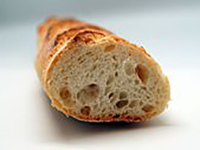 French baguette. |
The present form of the baguette appeared around 1890. New ovens, use of direct yeast, drawing of slits arranged at an angle, length of 70 x 6 centimeters and 300 gram weight. The method is simple: yeast is activated for 3 hours, without leaven or fermented paste. The ingredients are also simple: wheat flour, water, yeast, and common salt. No sugar, unlike the Czech/Austrian veka and New Orleans French bread. The French baguette is baked in a deck oven with steam injection. The oven is typically heated to well over 200 deg c (390 deg F). The steam allows the crust to expand before setting, thus creating a lighter, airier loaf. It also melts the dextrose on the bread's surface, giving the baguette a slightly glazed surface. It looks nothing like the New Orleans French bread.
But back to the Po-Boy. Now that we know that New Orleans French bread was introduced to the city by Germans, how did the Po-Boy originate? In the early years of the 20th century, Benny and Clovis Martin moved to New Orleans from rural Raceland. They found employment as streetcar conductors, and later opened a sandwich shop near the French Market. The po-boy was invented in 1929, when the Martin brothers began making free sandwiches for striking streetcar drivers. They referred to the striking men as "poor boys", or "po' boys" in the New Orleans lingo. The sandwiches were filled with whatever scraps were available, like beef gravy and french fries, or mayo, lettuce, and tomato.
The shape of New Orleans French bread began to change too, and depart from either the baguette or the Weckerl. They worked with local baker John Gendusa to develop an evenly sized 40-inch loaf, that could be cut into evenly sized pieces. A typical po-boy today is 10 inches long.
So much for the question of bread. The next important thing is fresh flavourful meat and golden-brown fried seafood. Here is a recipe from one of New Orleans star chefs, Gerard Maras.
Fried Oysters or Shrimp
Ingredients:
- 1 quart shucked oysters or peeled shrimp
- 1 tbsp hot sauce, preferably Crystal
- Salt and pepper
- 1 cup milk
- 2 eggs
- 1/3 cup flour
- 1-1/2 cups canola oil heated to 365 deg F
- 4 cups breading mix:
- 3 cups all-purpose flour
- 2 cups corn flour
- 1 cup corn meal
- 1/2 cup cornstarch
- 2 tbsp kosher salt
- 2 tbsp black pepper
- 2 tbsp dry thyme
- 3 tbsp paprika
- 2 tbsp chili powder
- 2 tbsp dry oregano
Preparation:
- Place the oysters or shrimp in a stainless bowl and season with the hot sauce, and salt and pepper. Mix the eggs with the milk, whisk in the flour, and pour into bowl with shrimp or oysters. Mix well.
- With a slotted spoon, remove some of the oysters or shrimp, let drain, and add to breading mix. Toss lightly, then carefully drop into the hot oil. Fry until lightly browned, about 3 minutes. Remove, drain on paper towels and salt if desired.
The final assembly of a po-boy is simple. Slice the French Bread lengthwise, spread mayonnaise on each half, fill with the fried seafood, and add shredded iceberg lettuce, sliced tomato, and pickles.
 Fried Shrimp Po-Boy |
 Fried Oyster Po-Boy |
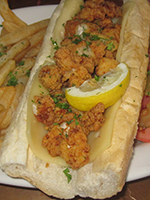 Fried Alligator Po-Boy |
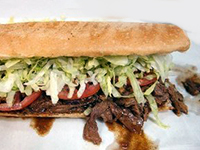 Roast Beef Po-Boy |
back to Radim and Lisa's Well-Travelled Cookbook | email us
Last updated: February 24, 2017